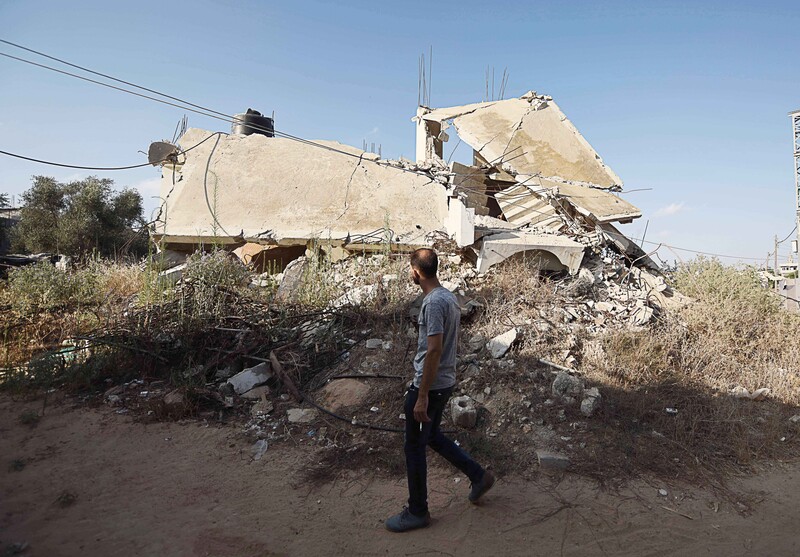The Electronic Intifada 19 July 2018

Rami Hamouda’s family remains displaced four years after their home was destroyed during Israel’s 2014 assault on Gaza.
Every morning Rami Hamouda visits the place where his home used to be. His children play football in its grounds as Rami sits nearby, hoping for a call on his mobile phone. He wants to hear when work on reconstruction will start.
The Hamouda family lived in Beit Lahiya, a city in northern Gaza. Their home was totally destroyed by Israeli forces in July 2014.
Four years later, the family is living in a temporary accommodation and lacks basic furniture. “We use cardboard boxes for arranging our clothes,” said Rami, 42.
Consisting of four stories, the building hosted 22 people, spread between six apartments.
In 2016, Gaza’s ministry of public works approved plans to reconstruct the building. Yet the job has not yet begun. Rami calls into the ministry’s headquarters at least once a month. Each time he is told that the file is still pending.
Rami’s sister Samah has struggled to cope with the cramped conditions in which she has lived since the building was bombed. “I have no privacy,” Samah, a 28-year-old kindergarten teacher, said.
“The missile that destroyed our house didn’t only destroy the walls,” she added. “It also destroyed our childhood memories, the lovely moments we had inside that house. Everything was gone in the blink of an eye. The psychological damage it caused will never be healed.”
Approximately 12,000 homes were destroyed by Israel when it attacked Gaza in the summer of 2014.
Following the offensive, an international conference – presented as an initiative to raise money for rebuilding Gaza – was held in Cairo. Governments taking part in the event pledged to donate a total of $3.5 billion. By March this year, less than $2 billion of that sum had been paid out, according to World Bank data.
Lack of funding has meant that the Gaza authorities frequently do not have money to begin repair or reconstruction work. Only 53 percent of all homes that were totally destroyed in 2014 have been rebuilt, Gaza’s public works ministry has calculated.
“How can I afford rent?”
The Shujaiya neighborhood in Gaza City became synonymous with a massacre committed by Israel in July 2014.
Ibrahim Jundiya’s home was severely damaged by Israeli shelling at the time of the massacre.
He and seven other members of his family still live in the home. That is despite the fact just one of its rooms is fit for habitation.
The Gaza authorities had previously given Ibrahim, 44, some money so that the family could find rented accommodation. “I was broke and I used the money to pay some bills,” he said. “They didn’t give us any further money.”

Firas Jundiya, 9, outside his family’s damaged home, in which they still live.
Ibrahim earns about $6 a day working as a driver. “What I make from my work doesn’t cover my basic expenses,” he said. “How can I afford to pay rent?”
Gaza’s public works ministry has sent engineers to assess the extent of the damage inflicted on the Jundiyas’ home. The engineers estimated that it would cost $20,000 to repair.
“Until this moment, I didn’t get a single dollar,” said Ibrahim. “The ministry keeps telling us that this is because donations have been frozen and due to the lack of a budget for reconstruction. It seems that we’ll have to continue living in this room.”
The situation has placed his family under considerable stress. “It feels really weird to live in a house like ours, especially at night,” said his 16-year-old son Abd al-Rahman. “It’s very scary. It feels like you’re in a ghost house.”
Naji Sarhan, a representative of Gaza’s public works ministry, acknowledged that “the reconstruction process is going very slow for several reasons.” The reasons include Israel’s siege on Gaza, delays in international donors delivering on aid pledges and divisions between the Hamas-run administration in Gaza and the Palestinian Authority in the West Bank, both of which are under Israeli occupation.
Aid is strictly monitored under the Gaza Reconstruction Mechanism. Nominally an international body, it has been established in such a way that Israel has a veto on whether any item may enter Gaza. Israel is also given personal details on every aid recipient.
That allows Israel “to control the [reconstruction] process,” Sarhan added.
“Exhausted”
At times, Israel has imposed restrictions on the entry of basic building materials such as cement. In recent days, the Israeli government has announced that it has placed new limits on the importation of commercial goods to Gaza.
Ibrahim Filfil lost both his home and his carpentry workshop because of Israel’s 2014 offensive.
Forty people were employed in his business, which was located in al-Tuffah, a neighborhood of Gaza City.

Ibrahim Filfil hasn’t been compensated for the loss of his carpentry workshop as a result of the 2014 war.
The reconstruction of Ibrahim’s home – also in al-Tuffah – has not yet begun. And he has not received any financial compensation for the loss of his business.
Ibrahim, 52, is the father of 11 children. The family is now living in a friend’s house.
“I was a businessman and was in a very good economic situation,” he said. “Now I’m waiting for the rebuilding of my house and for a tiny financial compensation. I never expected that I would have to go through this.”
Ibrahim and his wife Wafaa had hoped to organize a major celebration for when their eldest son Mohammed got married. Mohammed wed last year but their current circumstances meant that the party had to be much smaller than they wished. Mohammed is still living with his parents in their friend’s house.
“The tension has made my husband exhausted,” said Wafaa. “He rarely sleeps well. My husband was very calm and patient before this happened to us. Now he’s always angry.”
Sarah Algherbawi is a freelance writer and translator from Gaza.





